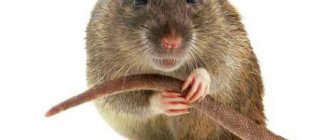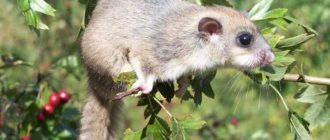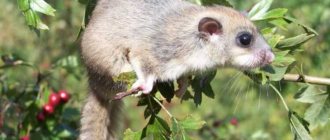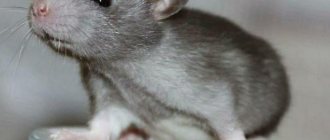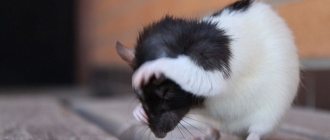Nobody knows when people first became acquainted with rats; this animal always lives next to us.
The rat belongs to the mammals, to the order - rodents, suborder - mouse-like. The most common animal on the planet is the rat.
Appearance of the rat, description and characteristics
The body of the rat is oval-shaped and stocky. The body of the animal is from 8 cm to 30 cm, weighing up to 500 g, there are small ones weighing 37 grams.
The eyes and ears are small, the muzzle is sharp and elongated. Is the tail longer than the size of the rat's body, hairless or covered with fine hair? invisible to the human eye (a type of black rat has a tail with a thick coat of fur). There is a species of short-tailed rodents in the world.A rat's teeth are arranged tightly together in rows and are designed for chewing food. These animals are omnivores; they differ from other predators in the absence of fangs and diastema - this is an area on the gums where there are no teeth.
There are no dental roots, so growth occurs continuously throughout the rat's life. For convenience, they need to constantly grind down their teeth, otherwise she will not be able to close her mouth.
The teeth are strong with hard yellow enamel, which makes it possible to easily chew through concrete, cement and hard various metals.
The rodent's body is covered with a thick, dense coat of guard hairs. The color range is varied, gray with different shades of dark or light, red, orange and even yellow.These amazing animals have movable toes on their paws, so they easily climb trees and prepare nests in hollows for habitat.
Rats are very active and agile animals, running 17 km a day and jumping up to 1 meter in height. They swim well, are not afraid of water and can catch fish.
Rats often turn their heads in different directions because they have a small viewing angle and see the world around them in gray tones.
Hearing functions perfectly, rats distinguish sounds with a frequency of up to 40 kHz (humans up to 20 kHz).
Life expectancy is from 1 year to 3 years. In laboratory conditions, rats can live 2 times longer.
Cubs
Little rats become attractive 2 weeks after their birth. They are born absolutely helpless - naked, deaf, blind, with undeveloped limbs and a short tail. Body weight does not exceed 6 g. Females actively suck nutritious milk and develop rapidly every day.
Already on the second day, down begins to appear on the back, finally covering the body after a week. The ears open after 5 days, the babies begin to hear rustling and squeaking of the female. After 2 weeks, the eyes appear. From this moment, the cubs begin to crawl out of the nest and explore their surroundings.
At 20 days, the formation of the body ends - the correct proportions, claws on the paws are clearly visible, and nipples appear in females. The molars begin to grow, the animals begin to feed on their own, eating all the food typical for adult rodents.
25 days after birth, the pups become similar to adults, but are smaller in size. The tail grows slowly. The development of the young generation finally ends at 12 months of age.
After a year, a young rat can produce healthy, strong offspring, although the ability to fertilize develops already by 1.5 months. The baby rat in the photo at different periods of his growing up is shown below.
Rats at different stages of life
On a note!
Already at 9 days of life, the size of the baby rats is equal to the dimensions of an adult mouse. You can distinguish a rat and a mouse by their unformed proportions and behavior. Little rats are not yet familiar with the feeling of fear of people.
Difference between rats and mice
Rats and mice are representatives of the same suborder, but they differ significantly in appearance and behavior.
The body of a mouse is small, up to 20 cm, weighing up to 50 grams, rats are twice as large, they are dense and muscular, weighing up to 900 grams.
Pronounced distinctive shapes of the head and eyes, in mice it is triangular and slightly flattened with large eyes, in rats the muzzle is elongated with small eyes.
A strong body and powerful toes allow rats to jump high up to 1 meter; mice cannot do such tricks.
- Detailed description with photos of all animals included in the Red Book of Russia
Zebra - habitats, appearance, diet and behavior, life cycle + 94 photos
Leopard - habitats, life cycle, rutting season and lifespan + 118 photos
Mice are cowardly animals and are afraid to appear in front of people, but this does not bother rats; they can defend themselves. There are many cases where they attacked a person.
Rats are omnivores, eating meat and plant foods. On the contrary, mice have a greater preference for cereals and seeds.
How to determine the type of spoiled food
You can also distinguish a mouse from a rat by the type of spoiled food.
If there are rodents in the house, you can determine their species according to the following behavioral characteristics:
- Cereals. When eating cereals, rats consume the grains without leaving any traces behind. Mice leave behind husks and spoiled grains.
- Small representatives of the family prefer to eat in only one place, while large ones cause serious damage to the household and food supplies, choosing new food sources each time.
If rodents have settled in the house, it is important to be able to determine their species, since control methods differ. To exterminate mice, you need to choose a trap or insecticides; to remove large rodents, you need to call professional exterminators, since these animals are extremely careful, cunning, and smart.
Why are rats dangerous?
Rats are a disaster for all humanity. They gnaw through walls in the basements of houses, sewer pipes, damage electrical mains, and damage crops.
Rats are carriers of more than 20 infectious diseases, such as leptospirosis, plague, salmonellosis, pseudotuberculosis and others. Many are dangerously fatal to human life.
It is difficult to exterminate rats using chemicals because the animal’s body quickly adapts to the poison and develops protective immunity to toxins.
Lifestyle
Rats are the most common animal in the world. They are not found only in the Arctic and Antarctica. These rodents are characterized by group living, with hundreds of individuals in one family. The community is controlled by an alpha male and 2-3 females. Each group of animals controls a territory of up to 2000 sq.m.
Rat families have specific habitats. Most animals prefer to stay close to humans, feeding on leftover food or supplies taken from storage.
Rats are a pet
Rats are ideal pets. They quickly become tamed to humans and recognize their owner by the face.
Neat and clean animals do not require special care. They will give their owner many funny moments; they are very interesting to watch.
But the owner of a pet rat should not forget that this is a social animal and it is difficult for him to live alone. The rat definitely needs a mate, otherwise a mental disorder may develop.
Intelligence
The mental abilities of these two representatives of the mouse family are also very different. According to scientists, rats are intellectually developed creatures.
- Firstly, they will not settle in places that are potentially dangerous for them.
- Secondly, they always examine the future home and assess the situation.
- Thirdly, they create entire communities with their own hierarchy and laws.
Norushki are more reckless in this regard, and therefore it is much easier to fight them, since you can easily deceive or outwit.
Type of rat, name and photo
There are about 70 species of rats in the world, most of which are little studied; below are common types of rodents with a brief description and photo of the rat.
The gray rat (pasyuk) is one of the larger species, up to 25 cm long, the tail is not taken into account. Weight from 140 grams to 390 grams, with a wide, elongated muzzle. The gray coat of young animals becomes orange with age. It lives near water, in dense vegetation and digs holes up to 5 meters.
The black rat is smaller in size than the gray rat, with a much smaller muzzle and rounded ears. Body length up to 22 cm, weight about 300 grams. A significant difference between this species of rodent is the tail, which is densely covered with hair and 4-5 times longer than the size of the body.
Lives in Asia, Africa and Europe. It can live for a long time without water, so it lives in dry places. The wool is black with a green tint.
The small rat differs from its fellows in size. Body length up to 15 cm maximum with body weight up to 80 grams. It has a brown coat color, a sharp muzzle and inconspicuous small ears. The tail is as long as the body without any signs of fur. Lives in Southeast Asia.
The long-haired rat is characterized by long hair and high activity. Males grow up to 18 cm, and females up to 16 cm in length. The tail is 4-5 cm smaller in size from the body. Habitat in arid deserts.
The Turkestan rat lives in China, Nepal, Afghanistan, and Uzbekistan. The fur is red, the belly is pale yellow, the body length is up to 23 cm. This variety is similar to the gray one, but has a denser body and a wide head in size.
Black-tailed rat or rabbit. It has average dimensions up to 22 cm, weight about 190 grams.
An interesting feature of this type of tail is a tuft of hair at the tip.
The back is gray and brown with visible black hairs.
They live in Australia and New Guinea mainly in eucalyptus forests, dense grass and shrubs. They lead an active lifestyle at night and hide in burrows during the day.Natural habitats
Rats can safely be called animals that appeared on earth even before man appeared on it. They are found in almost all corners of our Earth. Depending on the species, they are found both within the Euro-Asian continent and within other continents, including Australia, the Malay Archipelago, New Guinea, etc.
Yet their habitat is limited to northern, cold regions. Within central Russia there are no more than 2 species of rats - gray and black. If necessary, a rat can cover up to fifty kilometers in one day.
Rats are mammals that easily adapt to fairly difficult living conditions, which is why rats are often found at abandoned research stations in Antarctica.
Interesting and educational facts about the life of rats
In India there is a Karni Mata temple where rats are revered, cared for and protected. If the rules for caring for a sacred animal and killing it are violated, this person is obliged to bring a golden figurine in the form of a rat to the temple.
In some American states, it is illegal to hit a rat with a baseball bat and can result in a $1,000 fine.
In Asian and African countries, rats are considered a worthy delicacy for a festive dinner. Rat meat is considered a delicacy.
A gray rat eats up to 12 kg of various cereal products per year. Experts have calculated that every year about 6 kg of one farmer’s harvest is spent on feeding one rat.
Danger to humans
The confrontation between humans and rats has lasted for thousands of years. In our time, such a struggle has received an official name - rodent control. Despite its notoriety in Europe and many other countries, including the Americas, in some countries of the East this rodent received the status of a divine animal that symbolizes wealth, wisdom, prosperity, etc. The negative image of this rodent is associated with several plague epidemics in Europe, which were carried by rats.
Important point! Rats are involved in serious economic losses that are associated with spoilage and consumption of various types of goods, both food and other purposes. These rodents damage the insulation of electrical networks, which leads to fires that claim the lives of many people, not to mention damage to property.
Some species of rats cause serious damage to agricultural crops because they simply destroy crops. Therefore, in such conditions, people resort to various methods of protecting crops from rodent invasion. In some cases they are simply scared away, and in others they are physically destroyed. Currently, rats pose a serious threat to the health of all humanity, since these rodents carry pathogens of dangerous diseases. The danger of their vital activity also lies in the fact that these rodents are able to completely unnoticedly penetrate into a human home through sewage and ventilation systems.
Despite the constant and serious fight against rats and other rodents, it has not yet been possible to completely destroy them, but it is still possible to control the populations of these pests.
Experts have established certain norms for deratization, which is associated with the optimal percentage of freeing the territory from rodents.
Therefore it is considered:
- 80% – the result is satisfactory.
- 90% is a good result.
- 95% is an excellent result.
In this regard, it is generally accepted that the task of special deratization services is to maintain in a certain area an acceptable percentage of rodents that would not be able to cause much damage to human life.
Photo of a rat
Natural enemies
Rats try to avoid “communication” with representatives of canines and cats, as well as snakes and snakes. Their real enemies are: kites, eagles, owls. If foxes or beavers live in the region where rats live, a real war begins between them and the rodents.
In India, mongooses actively fight toothy pests. Some countries of the world (Japan, Colombia, New Zealand) periodically experienced an overabundance of breeding rats, threatening to destroy the entire harvest. In such cases, cats always came to the rescue, which were specially brought into the country to establish biological balance.




